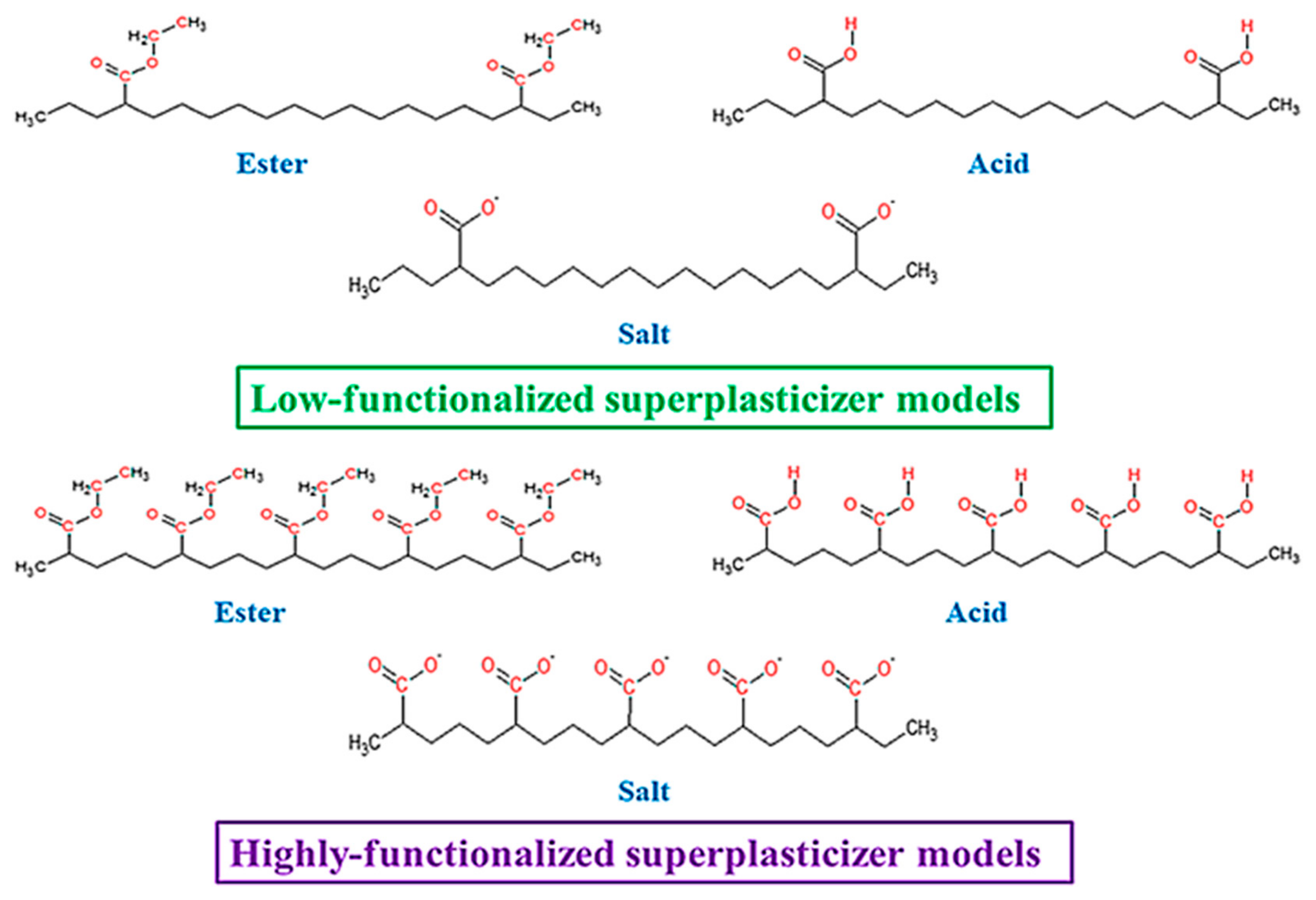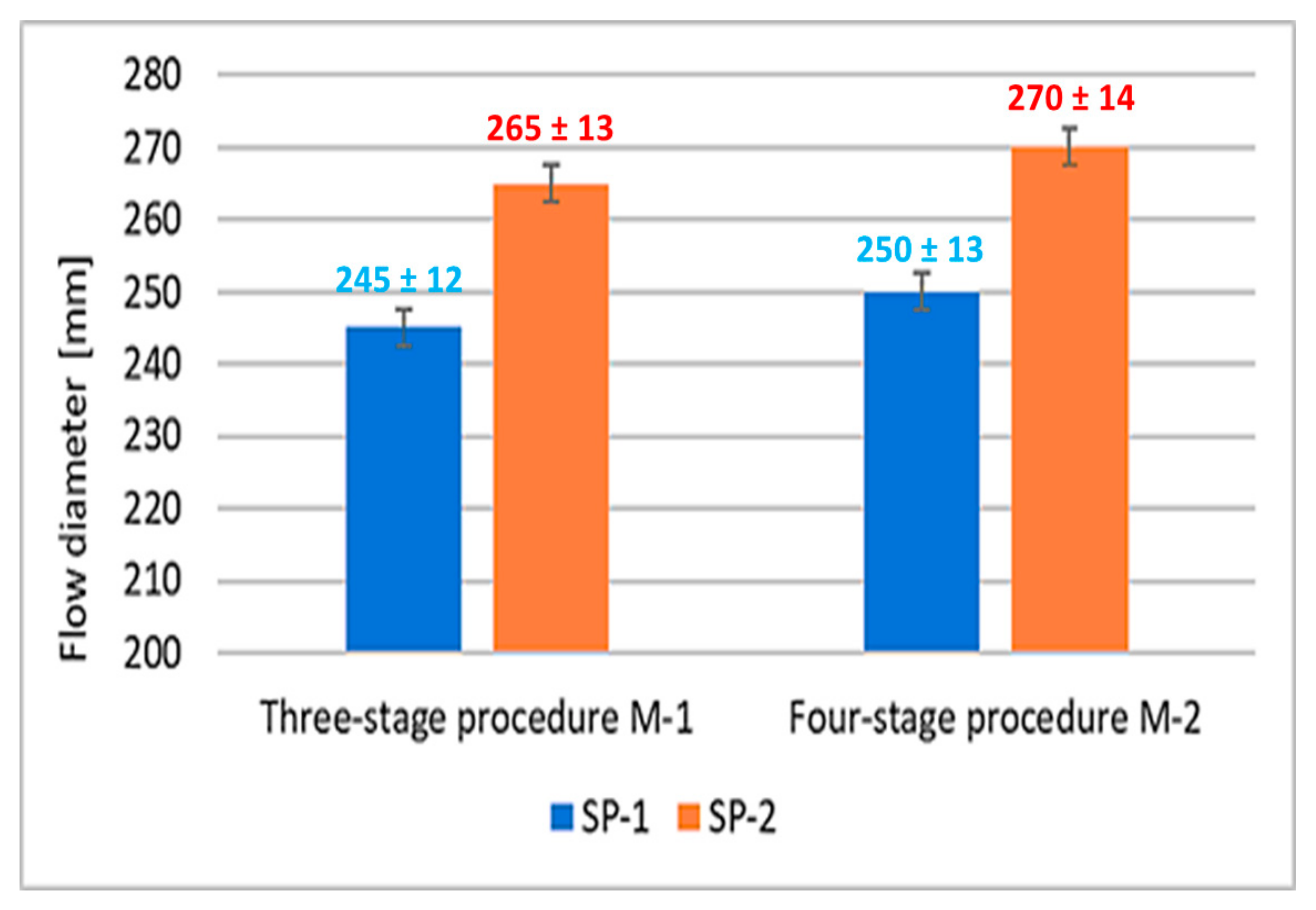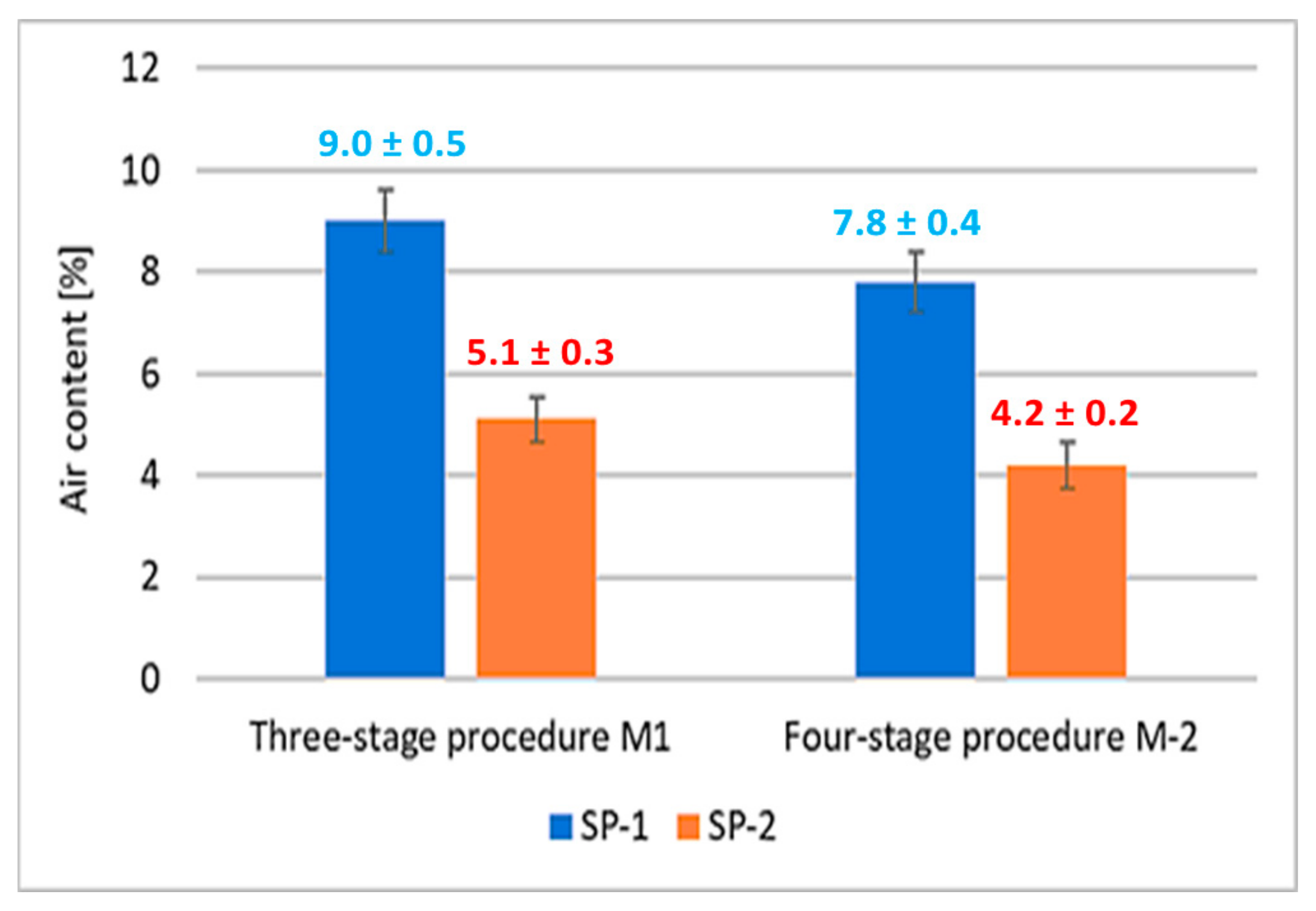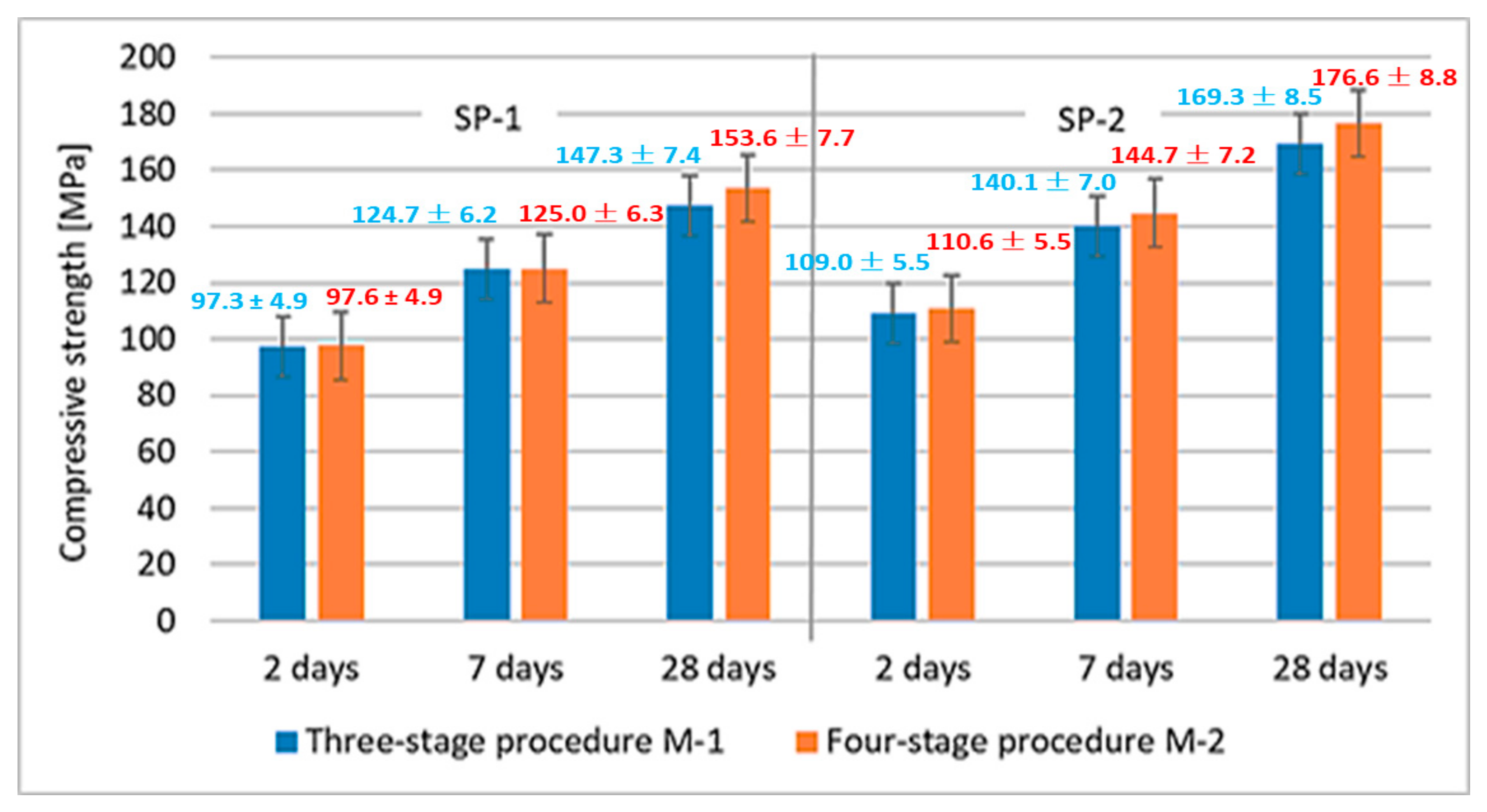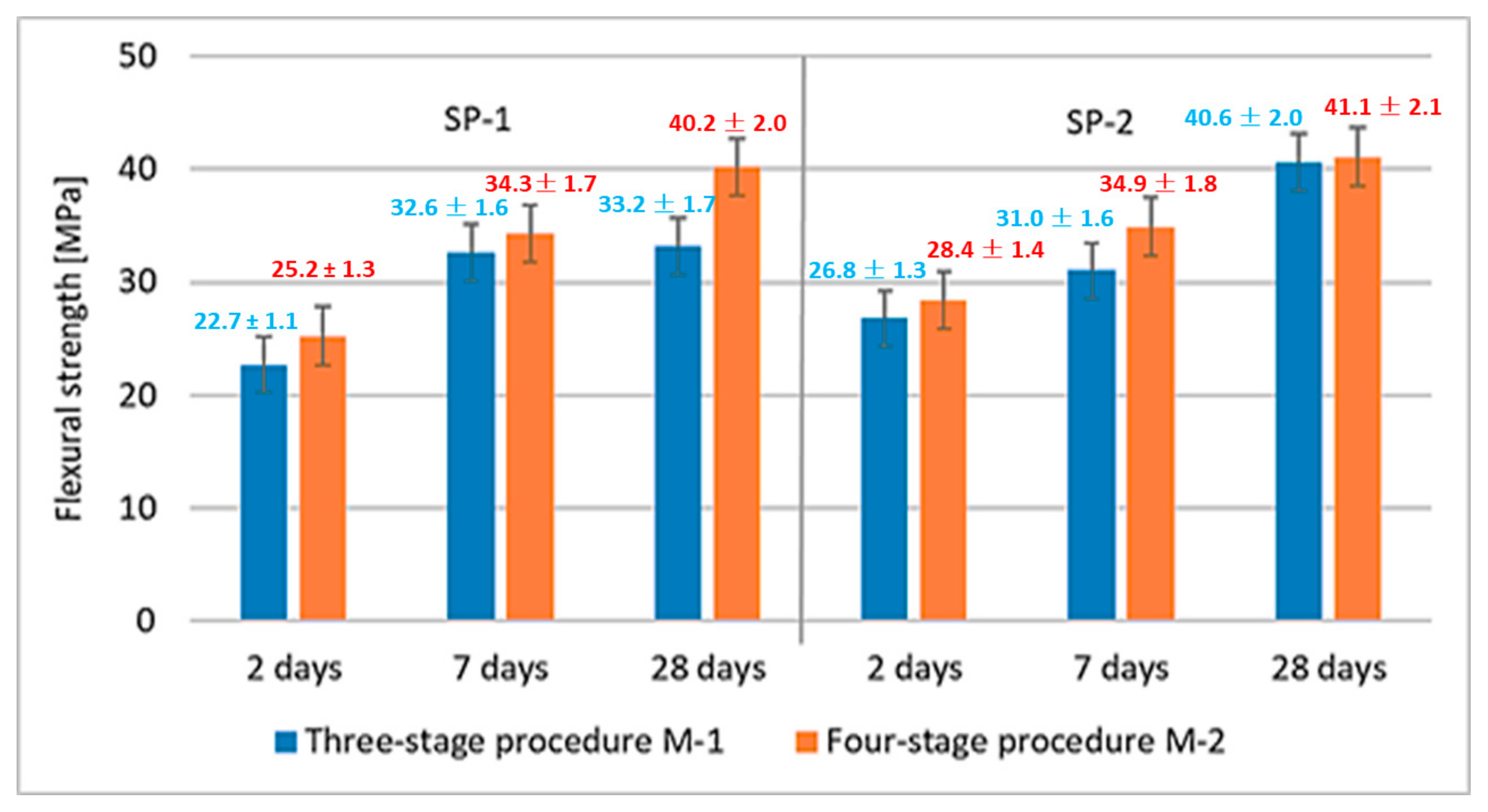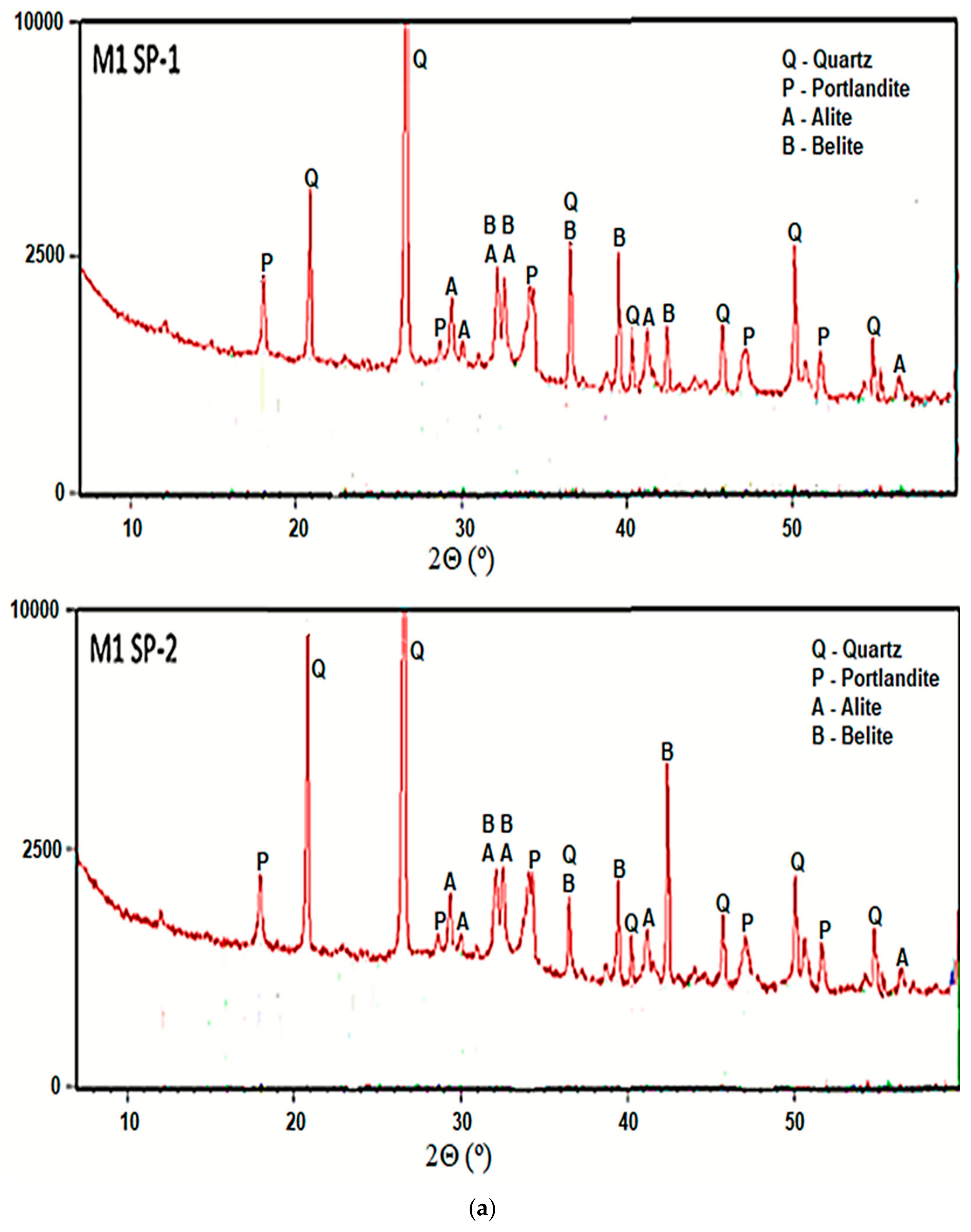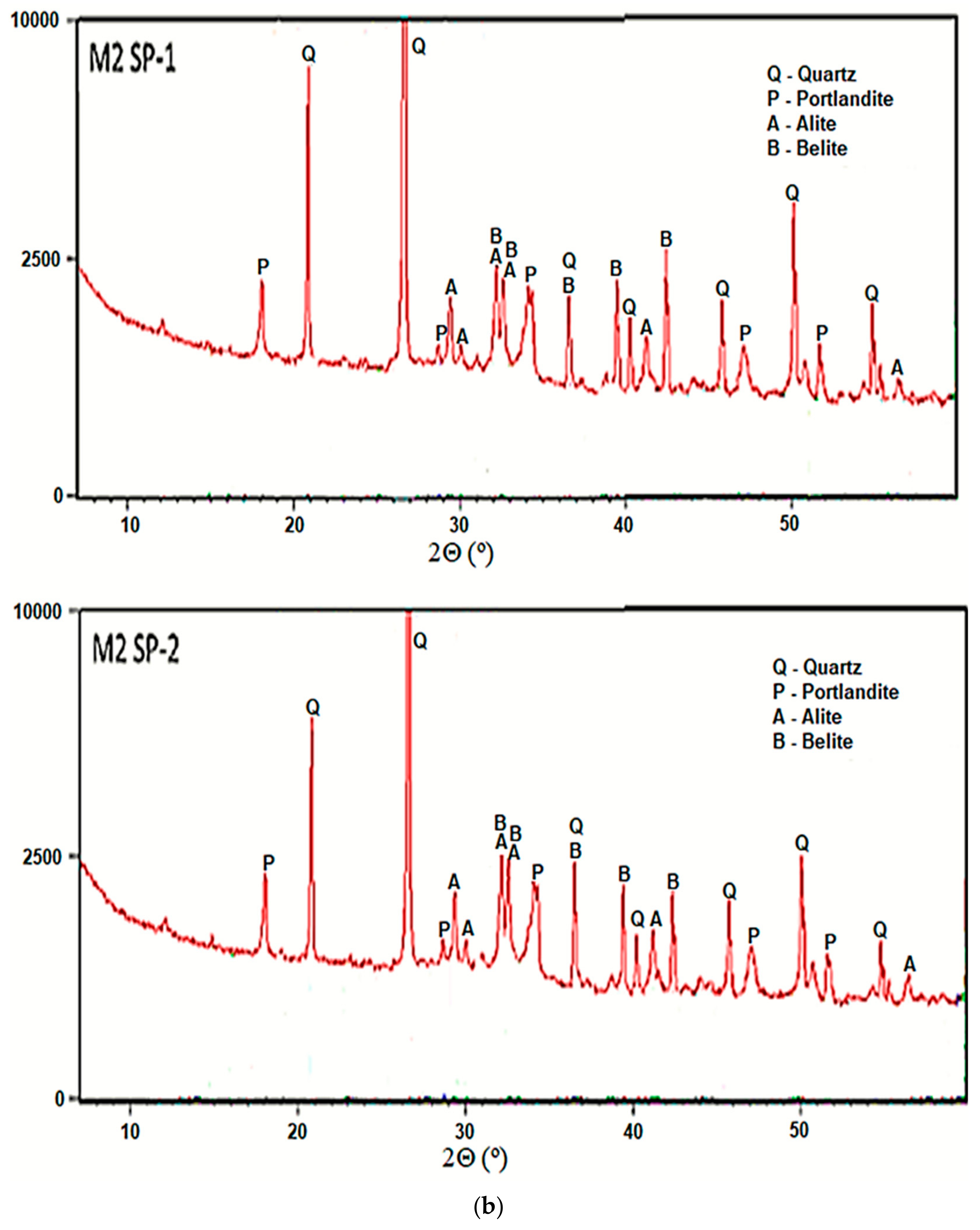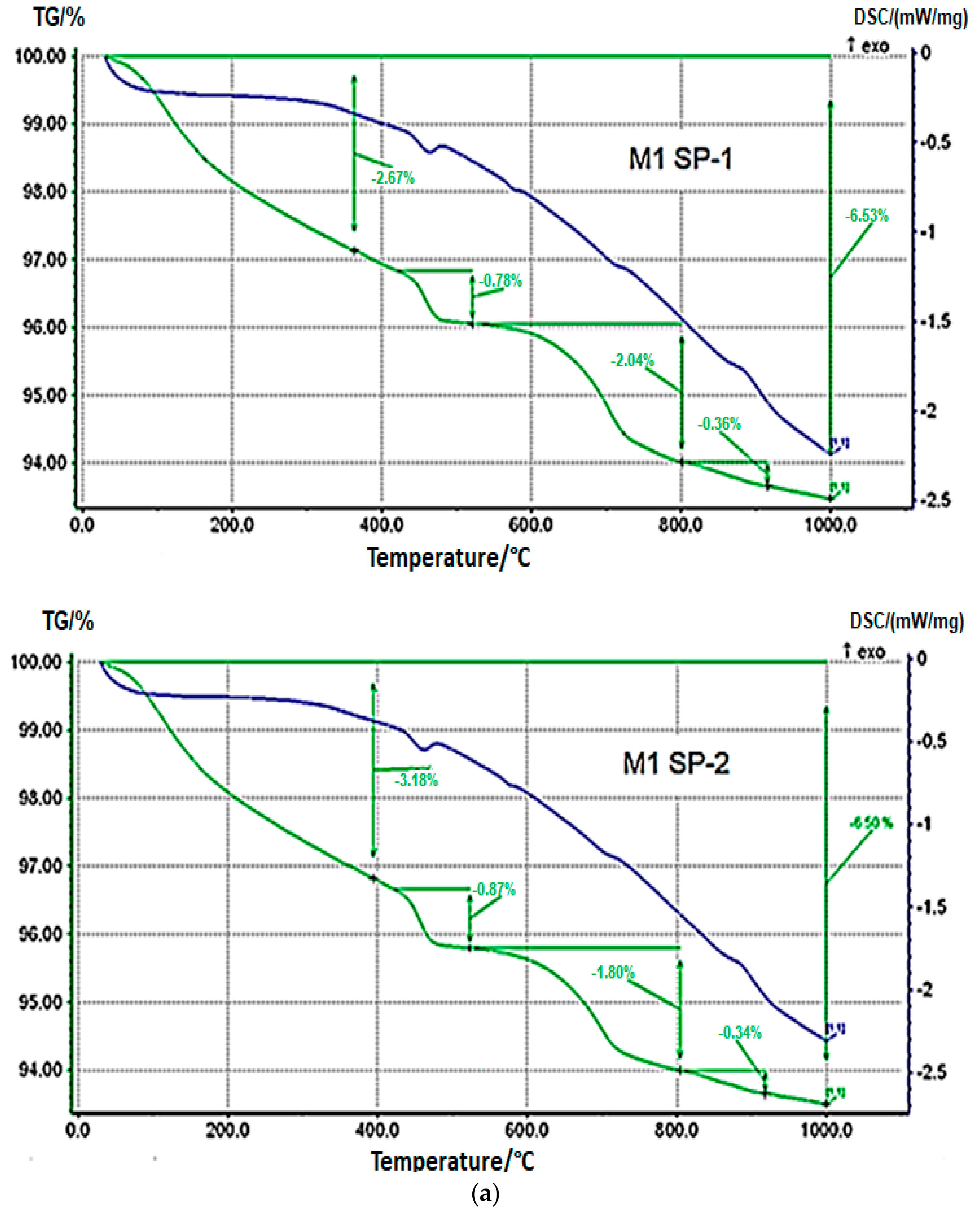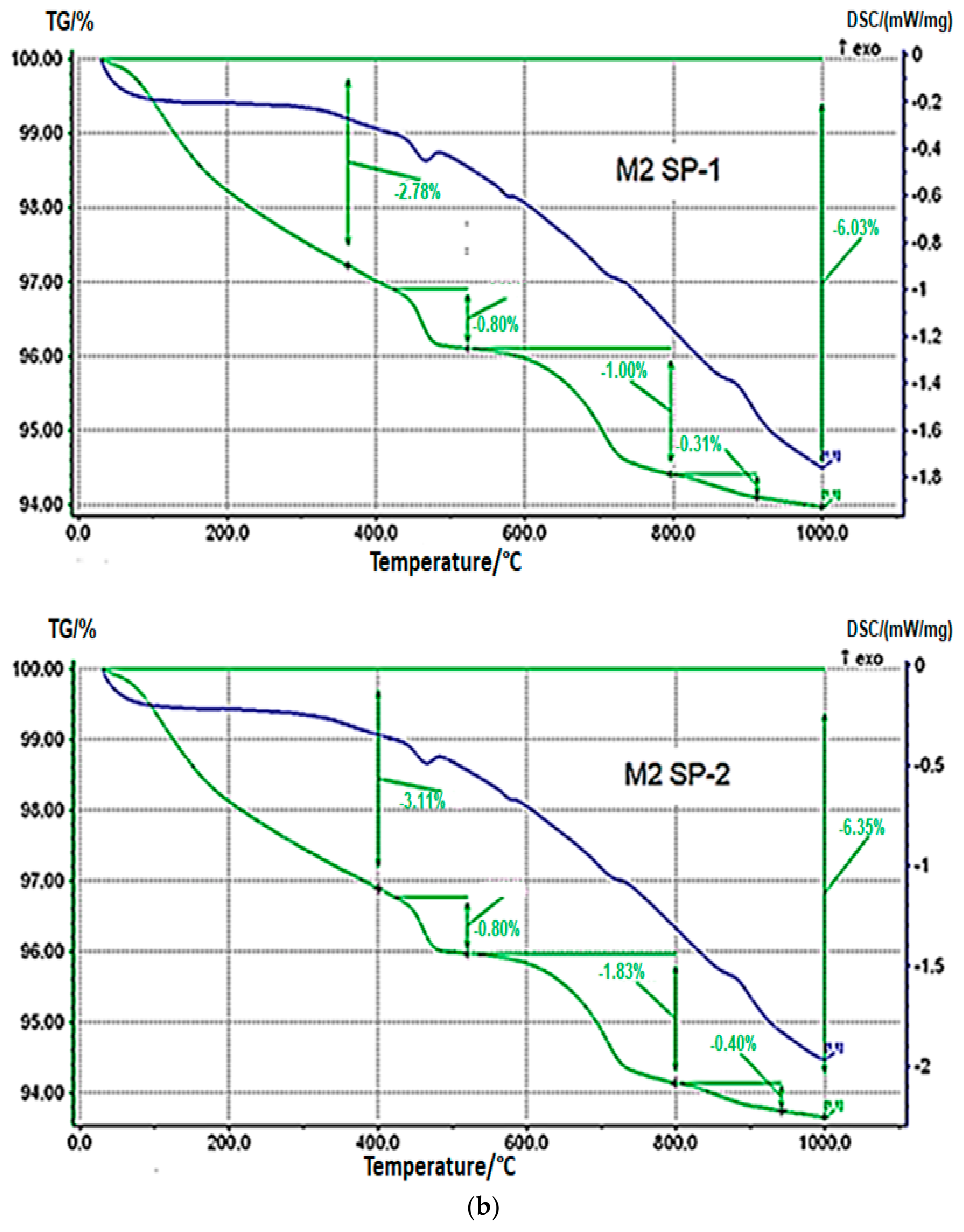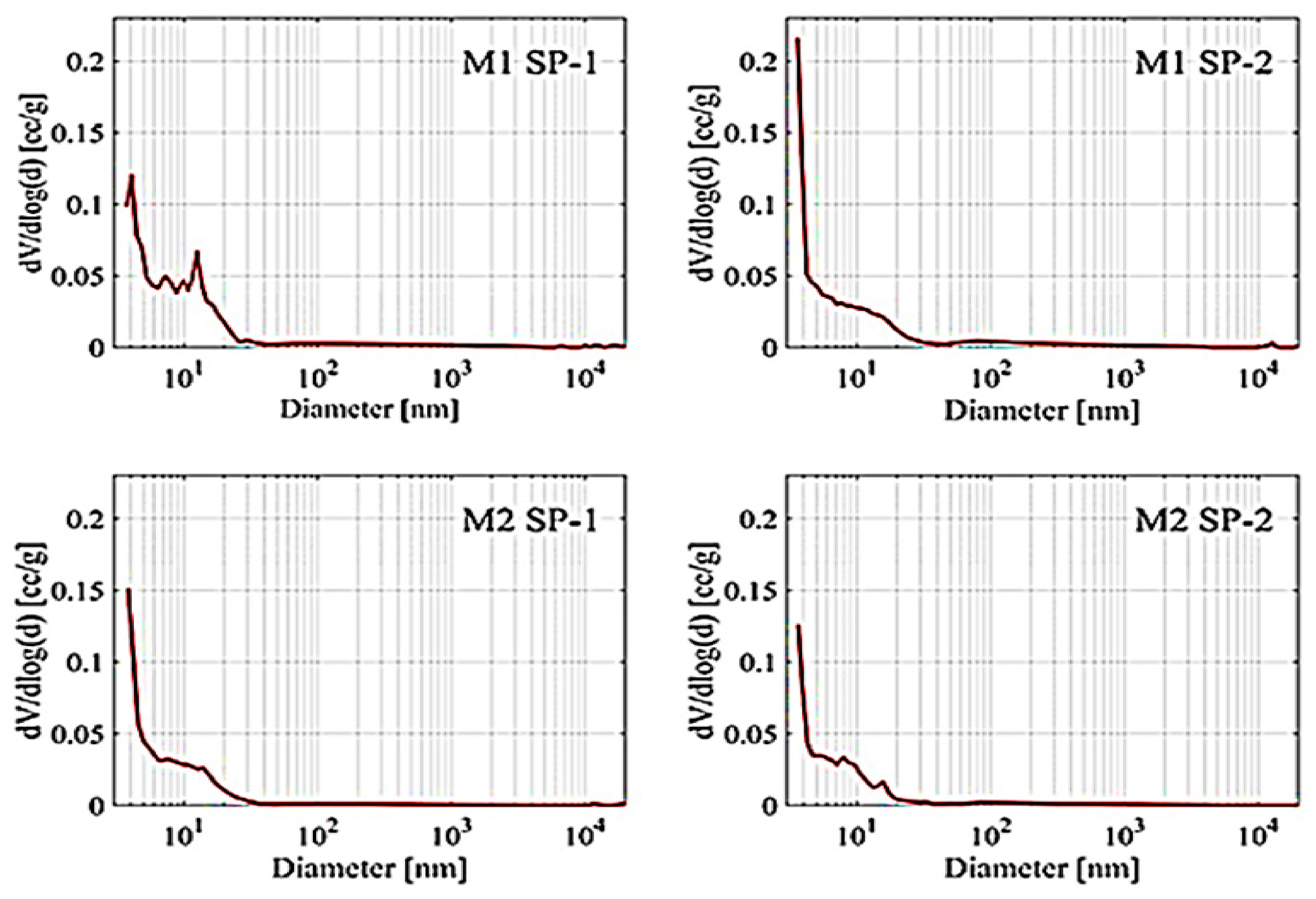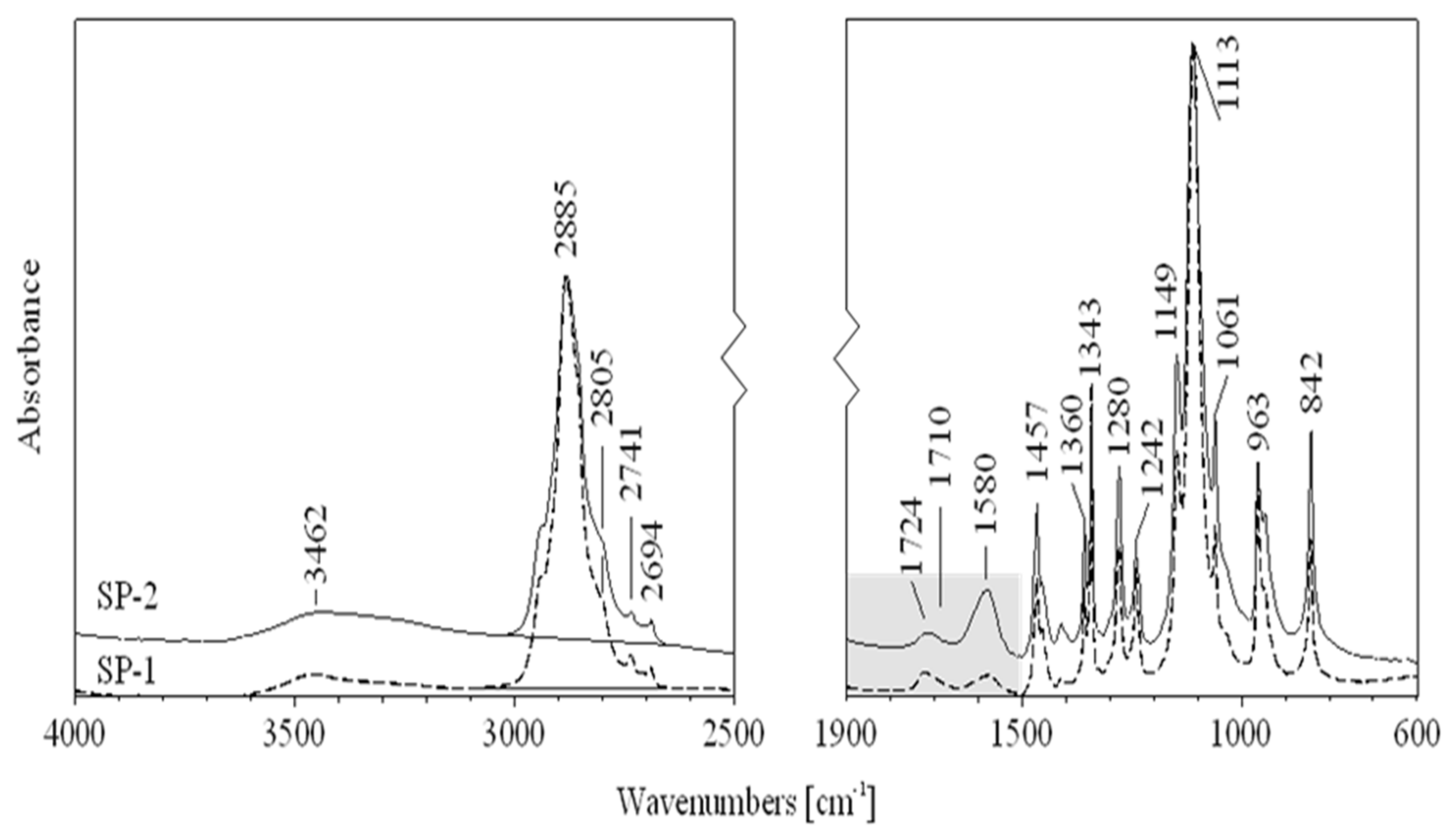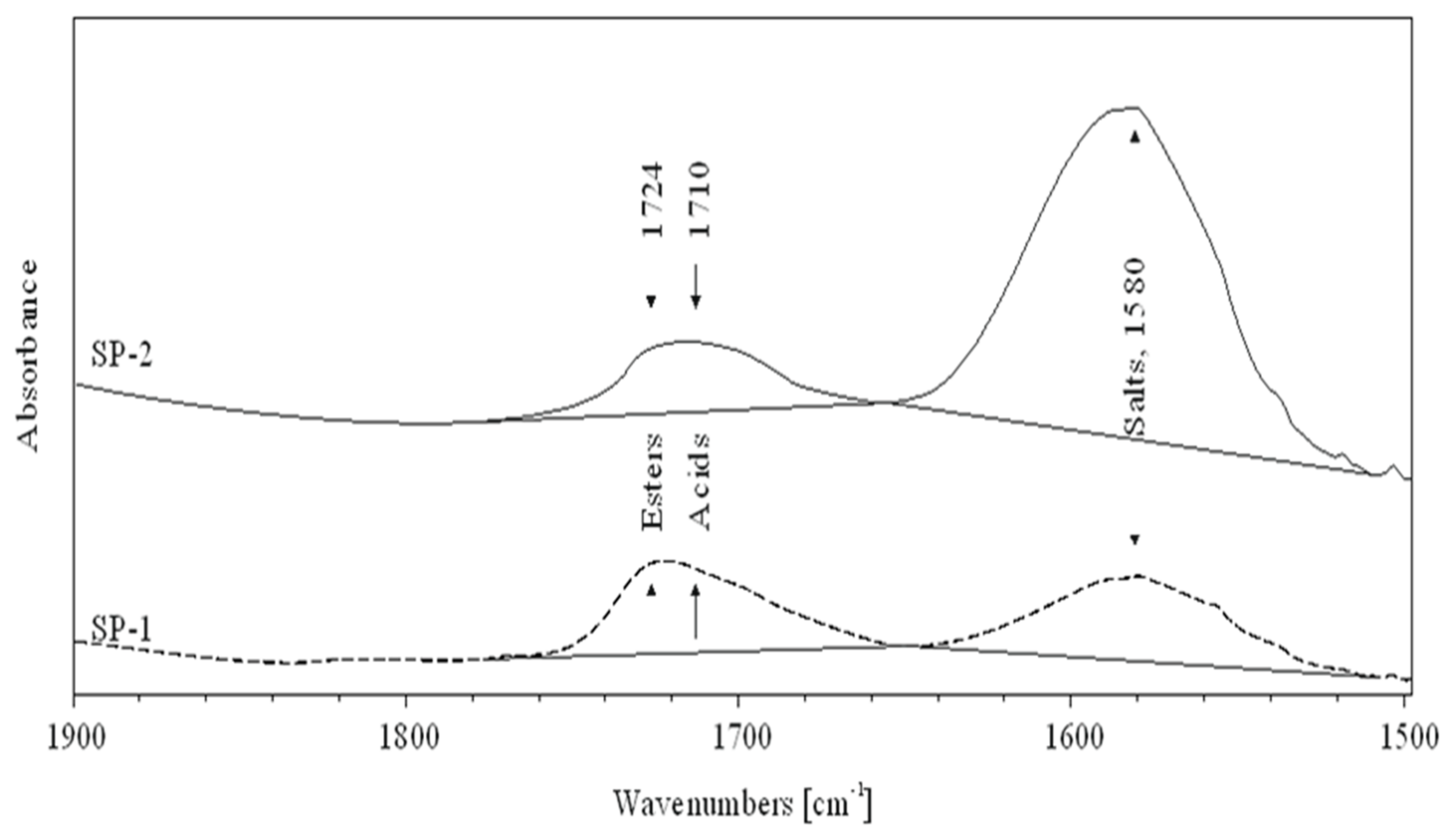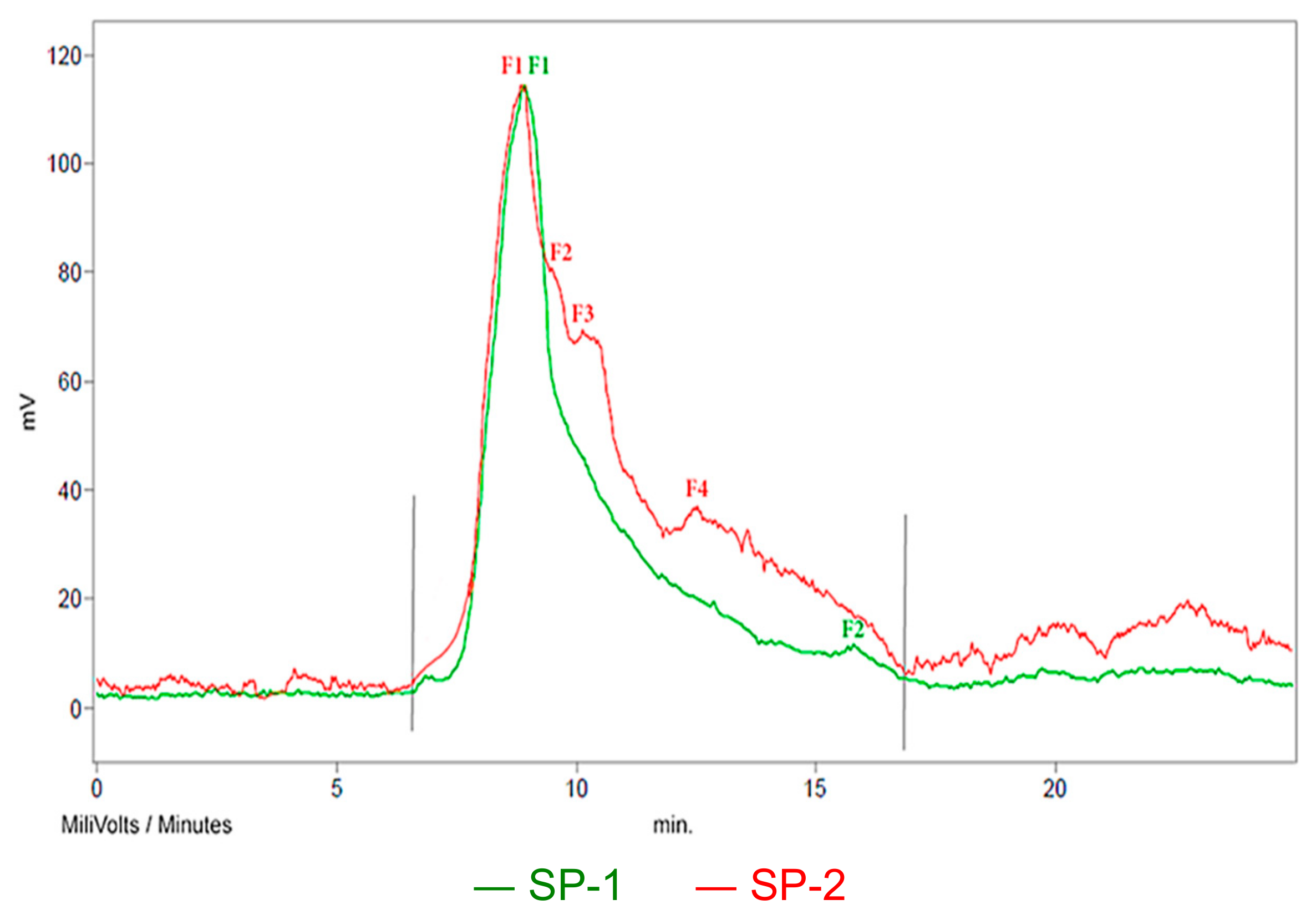1. Introduction
The progress in concrete technology is closely related to application of mineral additives and chemical admixtures. The effect of fine particles with a size below 10 μm in cement, introduced with mineral additives such as silica fume, fine fly ash and granulated blast furnace slag, as well as limestone powder, is of particular importance. These additives have a significant impact on the materials quality. In this case, modification of rheological properties is particularly important [
1,
2,
3,
4,
5]. Fine particles addition causes an increase in rheological values especially at a low water/binder (w/b) ratio. Therefore, it is necessary to apply superplasticizers, which in combination with fine particles have a significant effect on rheological properties of concretes [
1]. Mineral additives increase the particle packing density in the structure of high-performance cement-composites. In contrast, superplasticizers counteract electrostatic forces and ensure dispersion of fine particles and microfillers reduce viscous forces and friction between aggregated grains. The finer and wider the particle size distribution and the more spherical the microfiller particles are, the better rheological properties can be achieved [
4,
6]. A commonly used active mineral additive is silica fume. A small size of its particles (10–100 times smaller than cement grains), allows effective filling of spaces between cement grains [
7]. According to Bache [
8], silica fume is a key factor that increases superplasticizer effectiveness in cement paste. This opinion is also shared by Zang and Han [
9] and Kucharska [
10]. On the other hand, another research [
11] shows that a type of the superplasticizer also affects the SP interaction with a silica fume. The better interaction of the superplasticizer with silica fume in cement was described by higher flowability and has been observed for several other microfillers: finely ground granulated blast furnace slags [
5,
12,
13,
14], fly ash [
9,
15], or limestone powder [
1,
2,
16,
17]. Additionally, some studies suggest that fine mineral particles in the presence of the superplasticizer may cause deterioration of rheological properties of cement [
1,
13]. Achieving fluidity of the cement paste at a low w/b ratio (even below 0.2 in RPC mix), is possible by adding microfillers, which reduces the volume of water required to fill the material voids and increases the excess water to improve fluidity of the cement paste. However, sometimes this procedure is not enough due to the large specific surface area of fine particles. This leads to the formation of water layers on the surface of the microfiller or limits the deflocculation and dispersion of the paste particles by the superplasticizer [
6]. For this reason, observed differences in rheological properties of cement pastes containing microfillers are a result of many combined factors. The content of fine particles in cement, their grain size and grain shape composition and used cement type are decisive [
18,
19].
Other factor, which highly impacts the cement composite properties is the mixing procedure of mix ingredients with water [
20,
21,
22]. This is particularly evident at a low w/b ratio of RPC mixes with fine mineral additives. In general, the RPC mix requires longer mixing times to release water through finer pores [
21]. However, it was observed, that homogeneity of the mixture increases up to a certain time point, above which the segregation of ingredients takes place [
22]. The RPC mix preparation methodology has not been clearly established yet. Even for the same mix composition, properties of the fresh mix and the hardened RPC vary considerably when the mixing technique, mixing speed and mixing time are changed. The type of a mixer used also has a strong impact on the mixing efficiency and the mix homogeneity [
22]. In some papers focused on RPC, different authors have used their own mixing methods with different mixing speeds, duration and an order for dosing ingredients [
22,
23,
24,
25,
26,
27,
28,
29]. In these studies, the first stage of mix preparation is the dry mixing of ingredients, within 0.5 min to 3 min. Only in one case [
28] this time is longer, i.e., 7 min. In two works [
24,
28], the total amount of water with superplasticizer was added to dry ingredients and mixed within 3–4 min and 10 min, respectively. In other studies, water and superplasticizer were added in two stages, usually 50% of water and 50% of superplasticizer total amount on each time. A larger portion of water (80%, 87%) was also added at the first stage, where the superplasticizer was added at 100% and 50%, respectively [
22,
25]. The mixing time with the first batch of water and superplasticizer, applied by different authors, ranges from 2.5 min to 9 min, while the mixing time with the remaining amount of water ranges from 6 min to 25 min. The authors [
22] compared the effectiveness of a three-stage and a four-stage procedures for preparation of the RPC mix. In the three-step method, ingredients were first dry-mixed, then half the volume of water and half the amount of superplasticizer were added in the second step, and the remaining quantity of water and superplasticizer were added in the third step. In contrast, during the four-stage procedure, cement and silica fume were mixed dry at the first stage, 80% water and 100% superplasticizer were added at the second stage, the remaining mix ingredients, sand and quartz powder were added at the third stage and water (20%) was added at the fourth stage. Based on testing of the concrete microstructure and strength, the more favorable effect of the four-stage mixing procedure was demonstrated. Summarizing the results on RPC mix preparation methodologies, the multi-step mixing method, in terms of its flowability, is a better solution than the one-step preparation. It ensures better wetting of the mix grains at a low w/b ratio resulting in better flowability of the mix [
20,
21,
22]. However, it is difficult to make a definite recommendation for mixing the RPC ingredients on each mixing step, as too many factors affect the properties of the fresh mix and concrete.
A main task during RPC mix preparation is to ensure its flowability. In this case, a superplasticizer combined with fine particles plays a special role. An optimal SP amount, proper dosing time and the ingredients mixing time and speed play a key role in improving the effect of the superplasticizer on the concrete mix flowability. Technologies of state-of-the-art cement-based composite materials, which include reactive powder concretes, require application of more effective superplasticizers, compared to those used in the 1980s, based on sulfonated melamine-formaldehyde resins (SMF) and sulfonated naphthalene formaldehyde resins (SNF) [
30]. There are latest-generation polycarboxylate superplasticizers, multifunctional, regular and block copolymers, derivatives of acrylic, methacrylic and maleic acid [
31]. A vast majority of currently used more effective superplasticizers are acrylic copolymers. Acrylic copolymers are a wide group of compounds that differ in units` type and their sequence in a polymer chain. Therefore, their effect on the cement pastes fluidity may be different [
32]. A mechanism of polycarboxylate superplasticizers action is relatively well known. It is based on their adsorption on cement grains and, apart from anionic electrostatic interactions, in inducing a steric blocking effect by hydrated polyether side chains, which strongly deflocculates cement particles [
30]. Superplasticizers used together with microfillers containing fine particles are the basis of a RPC production [
30]. However, there are only few data [
33,
34,
35] on the effect of the chemical structure of polycarboxylate superplasticizers on RPC mix flowability. In addition, there is no data on the synergistic contribution of the SP structure and the mixing procedure on the properties of fresh and hardened cement. Therefore, this paper undertakes an examination of the effect of the chemical structure of a polycarboxylate-based superplasticizer on the properties of the mix and the hardened RPC. The research also takes into account the impact of the mixing procedure of the mix ingredients.
2. Materials and Methods
2.1. Composition of Concrete Mix
The following components were used to prepare the reactive powder concrete (RPC): Portland cement CEM I 52.5 R with a specific surface area of 410 m
2/kg from WARTA Cement Plant (Działoszyn, Poland), waste silica (0/45 μm) from Łaziska Steel Mill (Łaziska Górne, Poland), quartz powder (0/0.2 mm) and quartz sand (0/0.5 mm) from Osiecznica Aggregate Query (Osiecznica, Poland). Two types of polycarboxylate-based superplasticizer in 30% aqueous solution were used: SP-1 (BASF
®, Ludwigshafen, Germany) and SP-2 (ATLAS
®, Łódź, Poland) at 2.5% by weight of the cement, and WHS-12/0.2 steel fibers 12 mm long and 0.2 mm in diameter at 3% by volume. The chemical composition of the cement, silica, quartz powder and quartz sand is given in
Table 1.
Table 2 shows the grain size composition of components, determined using a Mastersizer 3000 laser grain size analyser (Malvern Panalytical Ltd., Malvern, UK). Cement contained fine particles in a range <5 μm, <10 μm and <20 μm. Cement contained 90% of particles smaller than 37.8 μm, quartz powder contained 90% of particles smaller than 49.1 μm, and for silica it is as high as 250.0 μm. Quartz aggregate contained 90% of particles smaller than 340.0 μm.
To assure the maximum increase of particle packing, concrete mix composition was optimized using Funk and Dinger curve [
36]. Four RPC mixes with the same w/b ratio of 0.24, differing in the type of superplasticizer (SP-1, SP-2) were prepared for testing. Composition of RPC mixes is given in
Table 3. Cement amount in the concrete mix was 876 kg/m
3.
2.2. Concrete Mixing Procedure
Components were mixed in HOBART HSM20 mixer (Offenburg, Germany) at a speed of 107 rpm. M1 and M2 procedures were used for mixing of RPC components. In M1 procedure (three-stage procedure), in the first stage all components were mixed dry for 1.5 min, then the assumed amount of water was added and mixed for 1.5 min. The next stage was a two-minute interval in mixing. The superplasticizer was in the third stage added and mixed for 10 min. In the M2 procedure (four-stage procedure), the first stage involved dry mixing of cement, silica and quartz powder for 1.5 min. In the second stage, 80% of water amount and the total amount of superplasticizer were added and mixed for 4.5 min. Sand was added in the third stage and mixed for 4.5 min. In the fourth stage, the remaining amount of water (20%) was added and mixed for approx. 4.5 min until the desired consistency was reached. Total time of mix preparation under the three-stage and four-stage procedures was comparable, i.e., 15 min. The M2 procedure involved analogous mixing stages as in the paper [
22], but the difference consisted in the change of duration of individual mixing stages and using the same mixing rate for all stages. In both cases, steel fibers were added in the final stage, to the flowing mixture and mixed for 1.5 min. The following RPC mix symbols were used for testing:
M1 SP-1—RPC mix with SP-1 superplasticizer mixed using three-stage procedure;
M1 SP-2—RPC mix with SP-2 superplasticizer mixed using three-stage procedure;
M2 SP-1—RPC mix with SP-1 superplasticizer mixed using four-stage procedure;
M2 SP-2—RPC mix with SP-2 superplasticizer mixed using four-stage procedure.
2.3. Experimental Methodology
The concrete particle size distribution was determined using particle size laser analyser Mastersizer 3000 within the range 0.01–3500 μm.
Tests of RPC consistence were performed in line with PN-EN 1015-3 standard “Methods of test for mortar for masonry—Part 3: Determination of consistence of fresh mortar (by flow table)” [
37]. Consistence was determined based on measurement of the concrete flow diameter (fluidic samples were used) with accuracy to 5 mm.
Air content in RPC mix was tested for 1 dm
3 samples in line with PN-EN 1015-7 standard “Methods of test for mortar for masonry—Part 7: Determination of air content of fresh mortar” [
38]. Air content in the mix was determined using a pressure method.
Compressive strength and flexural strength of RPC specimens were tested in line with PN-EN 1015-11 standard “Methods of test for mortar for masonry—Part 11: Determination of flexural and compressive strength of hardened mortar” [
39]. Measurements were performed on specimens 40 × 40 × 160 mm.
FTIR spectra of SP-1 and SP-2 superplasticizers were measured in a Thermo-Scientific FTIR spectrometer Nexus (Thermo Fisher Scientific Inc., Waltham, MA, USA) using the transmission method of liquid samples of both superplasticizers. Thin layers of liquid SP were placed on freshly pressed (transparent) KBr pellets. Spectra were recorded in a range from 4000 to 400 cm−1.
Determination of the molecular properties of the polymer samples of the tested superplasticizers (weight-average molar masses Mw (g/mol), molar number-average molar masses Mn (g/mol) and distribution of molar masses MWD, MWD = Mw/Mn) was performed by low-temperature gel permeation chromatography (GPC). These analyses were performed using a chromatographic system with a Knauer VWM 275 nm UV reflectance detector (Berlin, Germany). Asahipak GF 310 HQ 300 × 7.6 mm columns (Shodex™, Resonac, Japan) were used and DMF with 0.8% LiCl (DMF = N,N-dimethyl formamide) (Merck, Darmstadt, Germany) was applied as the eluent. These analyses were carried out for 1–2% solutions of the tested superplasticizer in DMF + 0.8% LiCl, maintaining a constant eluent flow through the columns of 0.5 mL/min at 30 °C. The “Grams/386 for Chromatography” software (Thermo Fisher Scientific Inc., Waltham, MA, USA) was used to process the chromatographic data. Standard linear polystyrene references were applied (IUPAC: Poly(1-phenylethane-1,2)) CAS 9008-53-6; -PS500, -PS920, -PS1250 (Merck, Darmstadt, Germany), -PS2850, -PS68000, -PS98300 (Merck, Darmstadt, Germany).
Thermogravimetric measurements were performed using a simultaneous thermal analyser—STA 449 F3 Jupiter (NETZSCH GmbH, Selb, Germany). An analytical sample of approximately 30 mg was introduced into an alumina crucible. The crucible was fitted with a lid to stabilise the atmosphere above the sample during measurement. Once the mass of the specimen had been determined, the crucible was placed on the DSC-TG carrier and the whole was put into the furnace. The temperature programme included specimen stabilization at 30 °C and heating up to 1000 °C at a rate of 10 °C/min.
Testing of RPC porosity was performed using a mercury porosimeter PoreMaster 60 (Anton Paar GmbH, Graz, Austria), within a pressure range from 1 to 400 MPa. Results were presented in a form of differential curves of pore size distribution. Every experiment was repeated in triplicate and all presented results are averaged.
2.4. Theoretical Methodology
Molecular modelling was performed to support FTIR data interpretation and SP chemical structure effect on cement mix and hardened composite properties description. Gaussian 16 C.01 program was used [
40]. Since both analysed superplasticizers SP-1 and SP-2 have a high molecular weight structure, it is difficult to calculate their structural and spectroscopic parameters. In addition, this work considers only contributions of certain functional groups of the superplasticizer. For this reason, simplified models were used that reasonably give the real structure of SP and the contribution of its modifications to the interactions with cement (see
Figure 1) [
41,
42]. All calculations were performed using density functional theory (DFT) in the gas phase. B3LYP hybrid density functional was used due to its efficiency in structural and spectroscopic parameters prediction [
43,
44,
45,
46]. Since the models used were quite large, relatively small basis sets were used: 3-21G, 6-31+G* and def2-TZVP [
47,
48]. In order to make the most accurate analysis of the experimental data using theoretical results, a comparative analysis was performed for all obtained data. The SP models were optimized at all considered levels of the theory. Simultaneously, the IR spectra were simulated. The absence of imaginary frequencies was accepted as a criterion for the equilibrium structure.
